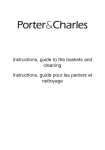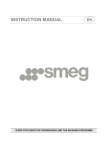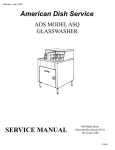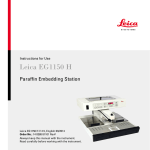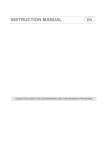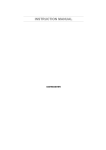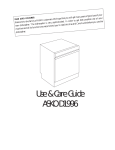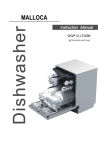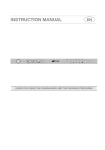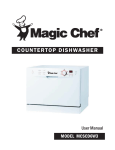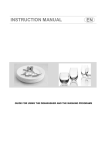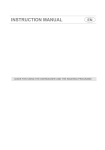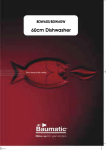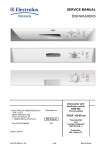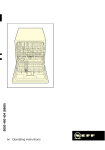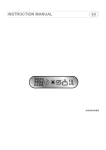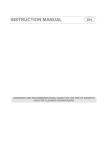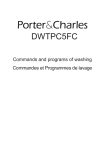Download Manual - AEG Appliances
Transcript
EN CONTENTS Contents 1.INTRODUCTION......................................................................................................................3 2. . 3. DESCRIPTION OF THE CONTROLS..................................................................................5 2.1. Upper panel.................................................................................................................5 2.2. Setting the washing program and switching on and off.............................6 2.2.1. Switching on................................................................................................................9 2.2.2. Selecting and starting the program................................................................. 10 2.2.3. End of program........................................................................................................ 10 2.2.4. Interrupting a program......................................................................................... 10 2.2.5. Changing the current program.......................................................................... 10 2.2.6. Canceling the current program......................................................................... 11 2.2.7.Options....................................................................................................................... 11 2.2.8. Switching off............................................................................................................. 12 2.2.9. Removing the dishes............................................................................................. 12 ENERGY SAVING AND ENVIRONMENTAL RESPECT.............................................. 13 4.TROUBLESHOOTING......................................................................................................... 14 5. OPERATING INSTRUCTIONS........................................................................................... 16 5.1. Using the rinse-aid and detergent dispenser............................................... 16 5.1.1. Adding the rinse-aid.............................................................................................. 17 5.1.2. Adjusting the rinse-aid dispenser setting...................................................... 17 5.1.3. Adding the detergent............................................................................................ 18 5.2. General warnings and recommendations..................................................... 20 5.3. Using the racks......................................................................................................... 22 5.3.1. Lower rack.................................................................................................................. 23 5.3.2. Cutlery basket........................................................................................................... 25 5.3.3. Upper rack................................................................................................................. 26 6. CLEANING AND USER MAINTENANCE....................................................................... 29 6.1. General warnings and recommendations..................................................... 29 6.2. Cleaning the water intake filter.......................................................................... 30 6.3. Cleaning the spray arms....................................................................................... 30 6.4. Cleaning the filter unit.......................................................................................... 32 6.5. General warnings and recommendations for correct maintenance.... 33 6.6. Troubleshooting minor problems..................................................................... 34 7. IMPORTANT SAFETY AND INSTRUCTIONS.............................................................. 36 8. INSTALLATION AND HOOK-UP...................................................................................... 42 9. TECHNICAL DATA................................................................................................................ 44 Rev. 0.0 1 EN 2 Rev. 0.0 EN INTRODUCTION 1INTRODUCTION Thank you for choosing one of our products. To use this dishwasher correctly and safely, please read this manual carefully. The manual is divided into sections giving you a step-by-step guide to all your appliance’s functions. The texts are easy to understand and are complete with detailed illustrations. Following the cleaning instructions provided here will keep dishwasher performance at peak levels in the long term. This userfriendly manual will provide answers to all your questions about use of the dishwasher. This manual comprises the following sections: INTRODUCTION: general information about the manual. USER INSTRUCTIONS: advice on using the washing programs and information about all the dishwasher functions. Useful advice is provided for the use of racks, spray arms, containers and filters. WARNINGS: a list of warnings concerning safety and use of the dishwasher. INSTALLATION INSTRUCTIONS: for the qualified technician who must carry out the installation, hook-up and testing of the appliance. Nomenclature of figures and tables: The progressive number of each figure is shown in the bottom righthand corner of the relative box. An example of a progressive number is “Fig. 4-01”, where the first number (4) indicates the section to which the figure belongs, while the second number (01) indicates the progressive number of the figure in section 4 (Fig. 4-01 is the first figure in section 4). The tables are numbered in the same way, bearing in mind that “Tab.” is used instead of “Fig.” (e.g.: Tab. 4-01 is the first table in section 4). If a table occupies more than one page, a letter is added after the progressive number (e.g.: “Tab. 4-01a”, Tab. 4-01b”). Rev. 0.0 3 EN INTRODUCTION Symbols used in this manual (see tab. 1-01) DANGER. This symbol highlights information and warnings which, if not observed, may compromise personal safety or damage the appliance. DANGER OF ELECTROCUTION. This symbol highlights information and warnings of an electrical nature which, if not observed, may compromise personal safety or damage the appliance. This symbol highlights general information and warnings. Tab. 1-01 4 Rev. 0.0 EN USER INSTRUCTIONS 2 DESCRIPTION OF THE CONTROLS 2.1 Upper panel All the dishwasher controls are grouped on the upper panel (see fig. 2-01). The dishwasher can only be switched on, programmed, switched off, etc. with the door open. A brief description (see tab. 2-01) of the various controls on the upper panel is given below. FIG. 2-01 Rev. 0.0 5 EN USER INSTRUCTIONS 1 2 3 4 5 6 7 8 9 10 11 On/off button Press to power the appliance. Program indicator lights These show which program is selected and whether there are any faults (Troubleshooting). Program selection button Press in sequence to select the required program. Add rinse aid indicator light (only fitted on some models) Shows the appliance has run out of rinse aid. Quick time option button Press this button to start one of the 4 quick time programmes (see table). Quick time programmes indicator light Shows that one of the 4 quick time programmes will be run Extra drying option button Press to select the extra drying option Extra drying option indicator light Shows the function is active Sanitation indicator light Shows that sanitation has been completed (see notes in the programmes table) Programme delay button Press to delay the start of the programme up to 9 hours. Information display Tab. 2-01 2.2 Setting the washing program and switching on and off The dishwasher is equipped with a control panel (see fig. 2-02) which is used to program the appliance and switch it on and off. FIG. 2-02 6 Rev. 0.0 EN USER INSTRUCTIONS To select the most suitable program for the dishes to wash, consult the following table which specifies the most appropriate type of washing sequence depending on the kind of dishes and how dirty they are (see tabs. 2-02a and 2-02b). PROGRAMME, NUMBER & SYMBOL 1 2 RINSE CRYSTAL LOAD CROCKERY AND CUTLERY Pans and dishes awaiting Cold prewash completion of the load Glass, china and mixed dishes with light dirt. 3 Half load of dishes with DAILY HALF normal dirt, LOAD washed immediately after use 4 Dishes with normal dirt, including dried-on residue NORMAL (2) EXTREME WASH 5 ETL SANITATION LISTED Rev. 0.0 PROGRAM PROGRESS Very dirty pans and dishes, including dried-on residue DURATION MINUTES (1) 15 CONSUMPTION ENERGY kWh (1) WATER 3,5 l 0,93 gal. 0,02 Wash at 45°C (113°F) Cold rinse Rinse at 70°C (158°F) Dry 65 12 l 3,17 gal. 0,5 Wash at 65°C (149°F) Cold rinse Rinse at 70°C (158°F) Dry 90 13 l 3,45 gal. 1,00 Wash at 50°C (122°F) Cold rinse Rinse at 66°C (150,8°F) Dry 100 12 l 3,17 gal. 0,7 Hot prewash Wash at 70°C (158°F) 2 cold rinses Rinse at 70°C (158°F) Dry 122 18,3 l 4,83 gal. 1,12 Tab. 2-02a 7 EN USER INSTRUCTIONS PROGRAMME, NUMBER & SYMBOL 6 7 8 9 LOAD CROCKERY AND CUTLERY PROGRAM PROGRESS DURATION CONSUMPTION MINUTES (1) WATER ENERGY LITRES kWh (1) RAPID 27’ Dishes with light dirt, washed immediately after use Wash at 38°C (100,4°F) Rinse at 50°C (122°F) 27 6,5 l 1,72 gal. 0,40 ECO QUICK Dishes with normal dirt, washed immediately after use. Cold prewash Wash at 60°C (140°F) Cold rinse Rinse at 70°C (158°F) 70 12,5 l 3,3 gal. 0,9 + NORMAL QUICK Dishes with normal dirt, washed immediately after use. Cold prewash Wash at 70°C (158°F) Cold rinse Rinse at 70°C (158°F) 80 13 l 3,44 gal. 1,1 + STRONG and FAST Mixed dishes with normal dirt without dried-on residues. Wash at 65°C (149°F) Cold rinse Rinse at 70°C (158°F) 55 9,5 l 2,51 gal. 1,00 + + Tab. 2-02b ( The cycle times and electrical energy listed use and care manual are based on normal soil loads (1) and 120°F (49°C) incoming water and will vary based on your actual conditions. (2) Program for energy star. - Only “EXTREME WASH” program conforms to NSF std 184 and is certified by INTERTEK with the ETL SANITATION LISTED. - When the “Sanitized” light shine it means that the dishwasher and its contents have been sanitized according to the requirements of the National Sanitation Foundation (NSF). - When the “AUTO PROGRAMMES” are selected, the dishwasher recognizes the type of dirt and automatically adjusts the washing parameters as appropriate. 8 Rev. 0.0 EN USER INSTRUCTIONS Only run the soak program with half loads. To run programmes 6, 7, 8, 9, 10 (see tab. 2-02b), select the required standard programme (see programmes 1, 2, 3, 4, 5 in tab. 2-02a) and then press the quick time option button (ref. 6 fig. 2-02). After using the above tables to choose the most suitable washing cycle, program the appliance. Before starting a washing program, make sure that: • The water supply tap is open. • The correct amount of detergent has been added to the dispenser (to add detergent, see the instructions in the general manual). • The spray arms are able to rotate freely and without obstruction. • The racks have been correctly loaded (see the instructions in the general manual). • The dishwasher door is securely closed. 2.2.1 Switching on Press the on/off button (ref. 1 fig. 2-02) to start the dishwasher. Then wait for one of the program indicator lights to turn on (ref. 2 fig. 2-02). Rev. 0.0 9 EN USER INSTRUCTIONS 2.2.2 Selecting and starting the program • Press the program selection button (ref. 3 fig. 2-02) several times until the indicator light corresponding to the required program turns on (ref. 2 fig. 2-02); • if required, press the relative buttons to select any complementary functions (e.g.: “extra drying”, “program delay”; see para 2.2.7 “options”); • close the door; the program will start after about 2 seconds and the relative indicator light will flash throughout the cycle (program¬ running signal). If the door of the dishwasher has not been closed or has been incorrectly closed, the washing cycle will not begin. QUICK TIME PROGRAMS FAST CYCLES OPTION OPTION • Select with anyany washing program (except the soak • Selectthis thisoption optiontogether together with washing program (except the prosoak gram) to SHORTEN the cycle by from a minimum of 10% to a maximum program) to SHORTEN the cycle by from a minimum of 10% to a maxiof 55%,ofdepending on the cycle selected. To activate option,this press the mum 55%, depending on the cycle selected. Tothis activate option, comes on) on) afterafter selecting the proQUICK TIME OPTION button press the FAST CYCLES button (light (light comes selecting the gram required. The The option is automatically deactivated at theatend theof program required. option is automatically deactivated the of end program. the program. 2.2.3 End of program The end of the program is signaled by a short beep. Additionally the indicator light of the normal and strong programs (marked “end”) flash. 2.2.4 Interrupting a program To interrupt the current program simply open the door of the dishwasher; to restart the program, simply close the door again. The program restarts from where it was interrupted. 2.2.5 Changing the current program To change the current program, simply open the door of the dishwasher and select the new program. Close the door to run the new program automatically. 10 Rev. 0.0 EN USER INSTRUCTIONS 2.2.6 Canceling the current program • To cancel the current program, open the door and press and hold down the program selection button (ref. 3 fig. 2-02) for a few seconds until the indicator lights of the fourth and fifth programs turn on (ref. pr. 4, pr. 5 fig. 2-03). • Close the door again. • After about 1 minute, the dishwasher terminates the cycle and the indicator lights of the fourth and fifth programs (ref. pr. 4, pr. 5 fig. 2-03) start flashing. FIG. 2-03 2.2.7 Options Function designed for loads with hard to dry item s such as saucepans, nonstick pans and plastic containers. Increases the hot rinse temperature and can be used in programmes featuring a final drying phase (see programmes table). PROGRAM DELAY (available for all programs except soak) The “Program delay” function delays the beginning of the washing program up to 9 hours from the moment in which programming takes place. This makes it possible to use the dishwasher at a certain time of day. Before programming a delay, open the door of the dishwasher, select the required washing program (see para 2.2 “Setting the washing program and switching on and off”). Select the day by pressing the Program delay button (ref. 11 fig. 2-02); each time you press the button, the display increases the delay before the appliance starts by 1 hour. Rev. 0.0 11 EN USER INSTRUCTIONS 2.2.8 Switching off At the end of the program, the dishwasher emits a short beep and the indicator lights of the fourth and fifth program (ref. pr. 4, pr. 5 fig. 2-04) flash. Turn off the appliance by opening the door and pressing the on/off button (ref. 1 fig. 2-02). FIG. 2-04 If it is necessary to open the door during the washing cycle, the program will be interrupted, the relative indicator light will continue to flash and a beep will indicate that the cycle has not terminated. Wait for about 1 minute before closing the door and continuing with the program. When the door closes, the program will start from where it was interrupted. This operation should be performed only if necessary as it could cause irregular program performance. 4 REMOVING THE DISHES 2.2.9 At the end of the washing program, wait at least 20 minute before removing the dishes in order to allow them to cool. To prevent any water droplets on the upper rack from falling onto the dishes in the lower rack, empty the lower rack first and then the upper one. 12 Rev. 0.0 EN USER INSTRUCTIONS 3 ENERGY SAVING AND ENVIRONMENTAL RESPECT Always try to run the dishwasher fully loaded. Do not wash the dishes under a running tap. Use the most suitable washing program for each type of load. Do not pre-rinse. If available, connect the dishwasher to a hot water system with a temperature of up to 60°C (140°F). • When possible, skip the drying cycle by opening the door after washing: the air and the residue heat will dry the dishes to perfection. • • • • • 3.1 Reducing the consumption of detergent and respecting the environment The phosphates contained in dishwasher detergents are harmful to the environment. To avoid using excessive amounts of detergent and to save on electricity: • Separate the more delicate items from those that are more resistant to aggressive detergents and high temperatures; • Do not pour the detergent directly onto the dishes. Rev. 0.0 13 EN USER INSTRUCTIONS 5 TROUBLESHOOTING The dishwasher can to signal a number of malfunctions by turning on various indicator lights, as described below (see following table): FAULT E1 E2 E3 E4 E5 DESCRIPTION Acquastop failure The anti-flooding system has tripped (only for models fitted with this feature). Activates in case of water leaks. Contact the technical assistance service. Safety level The system limiting the water level in the dishwasher has tripped. Interrupt the current program. Switch off the dishwasher, switch it back on again, program a new cycle and press start. If the problem persists, contact the technical assistance service. Water heating malfunction The water is not heated or is incorrectly heated. Repeat the washing program; if the problem persists, contact the technical assistance service. Water temperature monitoring malfunction Interrupt the current program. Switch off the dishwasher, switch it back on again, program a new cycle and press start. If the problem persists, contact the technical assistance service. Water intake malfunction The appliance does not take in water or does so incorrectly. Make sure the water connections are correct, that the water supply tap is open and that the filter is not clogged. If the problem persists, contact the technical assistance service. Tab. 5-01a 14 Rev. 0.0 EN USER INSTRUCTIONS FAULT E6 E7 DESCRIPTION Water pump-out malfunction The appliance does not pump out the water or does so incorrectly. Make sure the drain hose is not kinked or crushed and that the siphon and filters are not clogged. If the problem persists, contact the technical assistance service. Turbine flow-regulator malfunction (only for models fitted with this feature) The appliance is unable to precisely measure the quantity of incoming water. Interrupt the current program and switch off the dishwasher. Switch it back on again, program a new cycle and press start. If the problem persists, contact the technical assistance service. E8 Alternate washing system malfunction Interrupt the current program and switch off the dishwasher. Switch it back on again, program a new cycle and press start. If the problem persists, contact the technical assistance service. E9 Water intake system malfunction Contact the technical assistance service. Tab. 5-01b Light off Light on Light flashing If an alarm situation occurs, the dishwasher interrupts the current program and signals the fault. • Alarms E1, E2, E3, E4, E8, E9 immediately terminate the current program. • Alarms E5, E6 interrupt the current program and, after the problem has been eliminated, resume the cycle. • Alarm E7 is displayed at the end of the cycle which, however, is completed given that it does not jeopardize the operation of the dishwasher. To “reset” an alarm: • open or close the door, or switch the appliance on and back off again. At this point, the dishwasher can be programmed again. If the fault persists, contact the Authorized Technical Assistance Service. Rev. 0.0 15 EN USER INSTRUCTION 5 OPERATING INSTRUCTIONS BEFORE STARTING TO USE THE APPLIANCE, MAKE SURE YOU HAVE READ AND UNDERSTOOD ALL THE WARNINGS CONTAINED IN CHAPTER 2 “IMPORTANT SAFETY INSTRUCTION”. Once the dishwasher has been correctly installed, prepare for use as follows: • 5.1 add the rinse-aid and detergent. Using the rinse-aid and detergent dispensers The detergent and rinse aid dispensers are situated on the inner part of the door: the detergent dispenser (ref. A “ g. 4-03) is on the left, and the rinse-aid dispenser (ref. B fig. 4-03) is on the right. A B Fig. 4-03 WITH THE EXCEPTION OF THE SOAK PROGRAM, BEFORE EVERY WASHING CYCLE IT IS NECESSARY TO ADD THE REQUIRED AMOUNT OF DETERGENT TO THE DETERGENT DISPENSER. THE RINSE AID, ON THE OTHER HAND, SHOULD ONLY BE ADDED AS REQUIRED. 16 Rev. 0.0 EN USER INSTRUCTIONS 5.1.1 Adding the rinse-aid The rinse aid helps the dishes dry faster and prevents the formation of scale deposits and staining; it is automatically added to the water during the final rinse cycle, from the container situated on the inner side of the door. B A C Fig. 4-04 To add rinse aid: • Open the door. • Rotate the container cover (ref. A fig. 4-04) anticlockwise by ¼ of a turn and remove it. • Add the rinse aid until the container is full (approximately 140 ml). The optical level indicator (ref. B fig. 4-04), on the side of the cap should be completely obscured. Refill the rinse aid when the optical level indicator becomes clear again, or when the rinse aid warning light illuminates (see “Description of controls” manual). • Replace the cover (ref. A “ g. 4-04) by turning it in a clockwise direction until it is fully closed. • Use a cloth to remove any spillage of rinse aid which might lead to the formation of excess foam. 5.1.2 Adjusting the rinse-aid dispenser setting The rinse-aid dispenser can be set to one of 6 different levels. The dishwasher is factory set for medium water hardness (selector set to “3”). To change the setting, turn the dispenser selector (ref. c fig. 4-04) to the desired position: the amount of rinse-aid dispensed is proportional to the position of this selector. Make sure that the minimum amount of rinse-aid (selector turned to “1”) is approximately 1 ml and the maximum amount (selector turned to “6”) is approximately 6 ml. Rev. 0.0 17 EN USER INSTRUCTIONS • To adjust the rinse aid setting, rotate the dispenser cover (ref. A fig. 4-04) through a quarter turn in an anticlockwise direction and remove it. • Then use a screwdriver to rotate the rinse aid selector to the desired position. • Replace the cover (ref. A fig. 4-04) by turning it in a clockwise direction until it is fully closed. • The amount of rinse aid must be increased if the washed dishes appear dull or feature circular stains. • If, on the other hand, the dishes are sticky or have white streaks, it is necessary to reduce the rinse aid setting. 5.1.3 Adding the detergent DO NOT INHALE OR SWALLOW DETERGENT AS THIS MAY CAUSE BURNS AND/OR PERMANENT DAMAGE TO THE NOSE, MOUTH AND THROAT, AND EVEN LEADING TO SUFFOCATION; KEEP DETERGENT AWAY FROM YOUR EYES. IF ONE OF THE ABOVE SITUATIONS OCCURS, SEEK MEDICAL ASSISTANCE IMMEDIATELY. PREVENT CHILDREN FROM COMING INTO CONTACT WITH DETERGENT; KEEP THEM AWAY FROM THE DISHWASHER WHEN THE DOOR IS OPEN AS IT MAY CONTAIN DETERGENT RESIDUES. FILL THE DISHWASHER JUST BEFORE STARTING THE WASHING CYCLE AND THEN KEEP THE DETERGENT OUT OF THE REACH OF CHILDREN. To open the detergent dispenser cover, lightly press the relative button (ref. A fig. 4-05). Add the detergent and close the cover carefully, pushing down on the arrow (ref. B fig. 4-05). During the washing cycle, the dispenser will be opened automatically. A Fig. 4-05 18 Rev. 0.0 EN USER INSTRUCTIONS A B Fig. 4-06 • When a program with hot prewash is selected (see program table in the “Description of Controls” manual), extra detergent must be placed in the cavity (ref. A or B fig. 4-06, depending on models). • Only use dishwasher-specific detergents. For optimal washing results it is important to use a good quality detergent. • The detergent packs must be sealed and stored in a dry place to prevent the formation of lumps which may negatively affect washing results. Once opened the detergent packs should not be kept for too long, otherwise the detergent loses its effectiveness. • Do not use detergents formulated for washing dishes by hand, because they produce a great deal of foam and may negatively affect the operation of the dishwasher. • Add the correct amount of detergent. An insufficient amount of detergent will result in a partial removal of dirt from the dishes, whereas an excessive amount is wasteful and does not improve the washing results. • The market offers liquid and powder detergents with differing chemical compositions, which may contain phosphates, or be phosphate-free but contain natural enzymes. • Detergents containing phosphates are more effective against grease and starch at temperatures above 60°C (140°F). • Enzyme detergents, on the other hand, are also effective at lower temperatures (from 40 to 55°C / from 104 to 131°F) and are more easily biodegradable. With enzyme detergents it is possible to obtain at low temperatures comparable results to those which can only be achieved at 65°C (149°F) using traditional detergents. For the safeguarding of the environment we recommend the use of phosphate- and chlorine-free detergents. Rev. 0.0 19 EN USER INSTRUCTION • When using detergent tabs, place them in the cutlery basket. The dispenser has been designed for powder or liquid detergent. As the cover does not open completely d uring the washing cycle, t abs are not f ully released ( dissolved). This could generate the following problems: rinse cycle. THE INTRODUCTION O F DETERGENT INTO T HE R INSE A ID D ISPENSER, EVEN IN LIQUID FORM, WILL DAMA GE THE DISHW ASHER. 5.2 General warnings and recommendations recommendations concerning dish types to be washed and their loading. There are generally n o constraints on t he w ashing of domestic d ishes, but i n certain cases it is necessary to take their characteristics into account. Before loading the dishes into the racks it is necessary to: • soak any pots or pans with burnt-on food remains on the bottom to facilitate removal, then load them into the LOWERRACK. ” option (if available) for washing small amounts of dishes; Use the “ it saves water and electricity. When using this function, only load the rack se; the other rack must remain empty. There is no need to pre-wash the dishes under running water before loading them into the racks since this only wastes water. Correct loading of the dishes helps ensure optimal washing results. WARNING! • make sure that the dishes are securely in place so that they cannot tip over or obstruct the rotation of the spray arms during the washing cycle; • do not place very small objects in the racks as these could fall and obstruct the spray arms or the wash pump; • containers such as cups, bowls, glasses and pots should always be loaded with the opening facing downwards and with any cavities at an angle, to allow the water to drain out; • do not stack dishes or place them in such a way that they cover one other; • do not place glasses too close together because they may knock against each other and break, or there might be staining at the point where they touch. 20 Rev. 0.0 EN USER INSTRUCTION MAKE SURE that the items being washed are dishwasher-safe. Items which are not dishwasher-safe: • Wooden dishes, pots or pans: these may be damaged by the high washing temperatures. • Handcrafted i tems: these a re r arely suitable for washing in a d ishwasher. The relatively high water temperatures and the detergents used may damage them. • Lightweight objects: place lightweight objects in the upper rack where the water pressure is lower. • Dishes and objects in copper, tin, zinc or brass: these tend to stain. • Aluminum dishes: items made from anodizedaluminum may lose their color. • Silverware: silver items may stain. • Glass and crystal: in general, glass and crystal objects can be washed in the dishwasher. However, certain types of glass and crystal may become dull and lose their clearness after many washings. Therefore, for these items we recommend using the least aggressive program available (see “Description of controls” manual). • Decorated items: the decorated objects available on the market are generally able t o withstand washing in t he d ishwasher, although t he c olors may fade after a great many washes. If in doubt as to the fastness of the colors, it is advisable to wash just a few items at a time for approximately one month. Rev. 0.0 21 EN USER INSTRUCTION 5.3 Using the racks The dishwasher has a capacity of 13 place-settings, including serving dishes. Examples of loading 13 place-settings in the upper rack (see fi g. 4-07) and in the lower rack (see fi g. 4-08) are shown below. Fig. 4-07 Fig. 4-08 22 Rev. 0.0 EN USER INSTRUCTION 5.3.1 Lower rack The lower rack receives the full force of the lower spray arm, and should therefore be used for the “toughest” items with a heavier degree of soiling. All types and combinations of loads are permitted, provided that the dishes, pots and pans are arranged with all the soiled surfaces exposed to the water jets coming from the bottom. To make the most of the space inside the rack when loading large items, certain models are equipped with tip-up supports for plates in 2 or 4 sections (see fig. 4-09). With fixed supports Con supporti fissi With tip-up supports Con supporti ribaltabili Fig. 4-09 Rev. 0.0 23 EN USER INSTRUCTION Loading the lower rack (see fig. 4-10) Carefully load flat plates, soup plates, dessert and serving dishes, positioning them vertically. Pots, pans and their covers must be loaded upside down. When loading soup plates and dessert bowls, be sure to leave a gap between them. Loading examples: Fig. 4-10 24 Rev. 0.0 EN USER INSTRUCTION 5.3.2 Cutlery basket (see fig. 4-11/4-12 depending on models) The basket h as removable top grids i nto which items of c utlery s hould be inserted to keep them properly spaced and allow water to pass between them effectively. T he t op g rids a nd c entral l id a re i n the bag o f accessories. The central lid functions as a lid only. The top grids can be detached and used separately. The cutlery should be arranged in an orderly manner inside the basket, with the handles pointing downwards. Take care during loading to avoid injury from the knife blades. The basket i s suitable for all types of c utlery, except t hose l ong enough to interfere with the upper spray arm. Ladles, wooden spoons and cooking knives can be placed in the upper basket, making sure that the knife blades do not protrude from the basket. Fig. 4-11 The cutlery basket slides across the dishwasher and can be placed in any position to allow optimal use of the space in the bottom basket. Fig. 4-12 Rev. 0.0 25 EN USER INSTRUCTION 5.3.3 Upper rack (see fig. 4-13) Depending on the models, the basket may be equipped with some or all of the following accessories: - Supports f or cups o r long objects (ladles, s poons…), on t he l eft; can b e tipped to the vertical position when not in use. - Long-stemmed glass holder, on the left; to use, simply lift and fix onto the hooks provided. - Cutlery racks, on the right, designed for knives and teaspoons; for teaspoons, pull out t he s liding support. T he r acks can b e tipped to t he vertical position when not in use. - Fixed or movable racks in the middle. The movable supports can be fixed vertical, resting on the bottom of the basket when not in use, or set in the intermediate position, as required. Fig. 4-13 26 Rev. 0.0 EN USER INSTRUCTION Loading the upper rack (see fig. 4-14) Load plates facing forward; cups, bowls etc. must always be facing downwards. The left-hand side of the rack can be loaded with two layers of cups and glasses. The centre can be filled with plates and side-plates, fi tted upright into the supports provided. Loading examples: Fig. 4-14 Rev. 0.0 27 EN USER INSTRUCTION Adjusting the upper rack The upper rack can be set in three different positions on both sides. The rack must be level on both sides. To raise the rack (ref. A fig. 4-15), lift it with the two handles (e.g.: ref. B fig. 4-15) to the first or second catch depending on the height required. To lower it (ref. c fig. 4-15), pull up the two release levers (e.g.: ref. D fig. 4-15). This is also possible with the rack loaded, but in this case when lowering the rack it should be held steady with one hand to avoid knocking the dishes. C A B D Fig. 4-15 28 Rev. 0.0 EN USER INSTRUCTION 6 6.1 Rev. 0.0 29 EN USER INSTRUCTION 6.2 6.3 30 Rev. 0.0 EN USER INSTRUCTION Fig. 5-02 A Fig. 5-03 Rev. 0.0 31 EN USER INSTRUCTION 6.4 32 Rev. 0.0 EN USER INSTRUCTION 6.5 Rev. 0.0 33 EN USER INSTRUCTION 6.6 34 Rev. 0.0 EN USER INSTRUCTION Rev. 0.0 35 EN WARNINGS 7 IMPORTANT SAFETY INSTRUCTION (Save this instructions) THIS MANUAL FORMS AN INTEGRAL PART OF THE APPLIANCE: IT MUST ALWAYS BE KEPT INTACT TOGETHER WITH THE DISHWASHER. BEFORE USING THE APPLIANCE, CAREFULLY READ ALL THE INSTRUCTIONS CONTAINED IN THIS MANUAL. INSTALLATION MUST BE PERFORMED BY A QUALIFIED TECHNICIAN, IN COMPLIANCE WITH THE REGULATIONS IN FORCE. THIS APPLIANCE IS INTENDED FOR DOMESTIC USE AND SIMILAR APPLICATIONS SUCH AS THE STAFF KITCHENS OF SHOPS, OFFICES AND OTHER WORKPLACES, INSTITUTIONS, AND FOR THE USE OF GUESTS AT HOTELS, HOSTELS, BED AND BREAKFAST ESTABLISHMENTS AND OTHER RESIDENTIAL FACILITIES AND COMPLIES WITH DIRECTIVES 2006/95/EC AND 2004/108/EC CURRENTLY IN FORCE, INCLUDING THE PREVENTION AND ELIMINATION OF RADIO FREQUENCY INTERFERENCE. THE APPLIANCE IS DESIGNED FOR THE FOLLOWING PURPOSE: WASHING AND DRYING OF DISHES; ANY OTHER USE SHALL BE CONSIDERED IMPROPER. THE MANUFACTURER DECLINES ALL RESPONSIBILITY FOR USES OTHER THAN THOSE DESCRIBED ABOVE. THE NAME PLATE FEATURING THE TECHNICAL DATA, SERIAL NUMBER AND MARKINGS IS VISIBLY POSITIONED ON THE INNER EDGE OF THE DOOR. THE NAME PLATE MUST NEVER BE REMOVED. THIS APPLIANCE IS NOT SUITABLE FOR USE ON BOATS, CARAVANS OR THE LIKE. DISHWASHERS CERTIFIED FOR DOMESTIC USE ARE NOT SUITABLE FOR AUTHORISED FOOD FACTORIES. CHECK THAT THE VOLTAGE, FREQUENCY AND PROTECTION OF THE DOMESTIC MAINS POWER SUPPLY MATCH THE RATINGS ON THE NAME PLATE OF THE APPLIANCE. DO NOT LEAVING DISCARDED PACKAGING MATERIALS UNSUPERVISED WITHIN THE HOME. SEPARATE THE VARIOUS PACKAGING MATERIALS AND TAKE THEM TO THE NEAREST SORTED WASTE COLLECTION CENTRE. KEEP CHILDREN, PHYSICALLY AND/OR MENTALLY IMPAIRED ADULTS, AND ANIMALS AWAY FROM PACKAGING WASTE; DANGER OF SUFFOCATION. 36 Rev. 0.0 EN WARNINGS BEFORE PROCEEDING WITH INSTALLATION, DISCONNECT THE MAINS POWER SUPPLY FROM THE WORK AREA. DO NOT USE EXTENSION CORDS, ADAPTORS OR SHUNT CONNECTIONS IN ORDER TO AVOID THE POSSIBILITY OF OVERHEATING OR BURNING WITH CONSEQUENT FIRE HAZARD. DURING INSTALLATION, TAKE CARE NOT TO INJURE YOURSELF ON THE SHARP EDGES OF THE APPLIANCE; WEAR SAFETY GLOVES. THE APPLIANCE MUST BE PROVIDED WITH AN EARTH CONNECTION IN ACCORDANCE WITH THE ELECTRICAL SAFETY REGULATIONS IN FORCE. IF IN DOUBT, HAVE THE SYSTEM CHECKED BY A QUALIFIED ELECTRICIAN (SEE ALSO THE WARNINGS INDICATED IN CHAPTER 3). THE MANUFACTURER DECLINES ALL RESPONSIBILITY FOR DAMAGE TO PERSONS OR PROPERTY RESULTING FROM THE FAILURE TO EARTH THE APPLIANCE OR FROM A DEFECTIVE EARTH CONNECTION. ALWAYS SWITCH OFF THE DISHWASHER AFTER EACH USE TO AVOID WASTING ELECTRICITY. IN THE EVENT OF A FAULT, DISCONNECT THE DISHWASHER FROM THE ELECTRICAL POWER SUPPLY AND SHUT OFF THE WATER TAP. DO NOT USE APPLIANCES WHICH HAVE BEEN DAMAGED DURING TRANSIT! IF IN DOUBT, CONSULT YOUR DEALER. THE APPLIANCE MUST BE INSTALLED AND CONNECTED IN ACCORDANCE WITH THE INSTRUCTIONS PROVIDED BY THE MANUFACTURER OR BY A QUALIFIED TECHNICIAN. ONLY USE DETERGENTS SPECIALLY FORMULATED FOR DISHWASHERS. DO NOT USE DETERGENTS FORMULATED FOR WASHING DISHES BY HAND. ONLY USE RINSE”AID SPECIALLY FORMULATED FOR DOMESTIC DISHWASHERS. Rev. 0.0 37 EN WARNINGS DO NOT INHALE OR SWALLOW DETERGENT AS THIS MAY CAUSE BURNS AND/OR PERMANENT DAMAGE TO THE NOSE, MOUTH AND THROAT, AND EVEN LEADING TO SUFFOCATION; KEEP DETERGENT AWAY FROM YOUR EYES. IF ONE OF THE ABOVE SITUATIONS OCCURS, SEEK MEDICAL ASSISTANCE IMMEDIATELY. TO PREVENT CHILDREN FROM COMING INTO CONTACT WITH DETERGENT, FILL THE DISHWASHER JUST BEFORE STARTING THE WORK PROGRAM AND THEN KEEP THE DETERGENT OUT OF THE REACH OF CHILDREN. THIS DISHWASHER MUST BE USED BY ADULTS. USE BY PERSONS WITH REDUCED MENTAL AND/OR PHYSICAL CAPABILITIES IS ONLY PERMITTED UNDER THE SUPERVISION OF A PERSON RESPONSIBLE FOR THEIR SAFETY. DO NOT ALLOW CHILDREN TO APPROACH AND/OR PLAY IN OR ON THE DISHWASHER. THE APPLIANCE MAY CONTAIN RESIDUES OF DETERGENT WHICH CAN CAUSE PERMANENT DAMAGE TO THE EYES, MOUTH AND THROAT, AS WELL AS POSSIBLE DEATH BY SUFFOCATION; IF THE ABOVE OCCURS, SEEK MEDICAL ASSISTANCE IMMEDIATELY. BEWARE; IT IS POSSIBLE FOR CHILDREN TO GET TRAPPED INSIDE THE DISHWASHER! DO NOT INTRODUCE SOLVENTS SUCH AS ALCOHOL OR TURPENTINE WHICH MAY CAUSE AN EXPLOSION. DO NOT POUR POWDER AND/OR LIQUID DETERGENT INTO THE RINSEAID CONTAINER AS THIS WILL DAMAGE THE CONTAINER. DO NOT POUR POWDER AND/OR LIQUID DETERGENT INTO THE WASTER SOFTENER TANK AS THIS WILL DAMAGE THE TANK. DO NOT USE INDUSTRIAL DETERGENTS AS THIS MAY DAMAGE THE APPLIANCE AND/OR TRIGGER VIOLENT CHEMICAL REACTIONS (E.G. EXPLOSIVE GAS). DO NOT LOAD DISHES THAT ARE SOILED WITH ASH, WAX OR PAINTS. DO NOT INTRODUCE ITEMS IN HEAT-SENSITIVE PLASTIC, SUCH AS DISPOSABLE CUTLERY OR PLATES, AS THESE MAY BECOME DEFORMED. DO NOT WASH OBJECTS IN PLASTIC UNLESS THEY ARE MARKED “DISHWASHER PROOF” OR THE LIKE. FOR UNMARKED OBJECTS, FOLLOW THE INSTRUCTIONS OF THE MANUFACTURER; IF NO INFORMATION IS AVAILABLE, DO NOT WASH THESE OBJECTS IN THE DISHWASHER. 38 Rev. 0.0 EN WARNINGS DO NOT INTRODUCE ANIMALS INTO THE DISHWASHER. WHEN OPENING THE DISHWASHER DOOR DURING A CYCLE THERE IS A RISK OF SCALDING DUE TO THE HEAT CONTAINED INSIDE; DO NOT GET IN THE WAY OF THE STEAM LEAVING THE APPLIANCE AND DO NOT TOUCH THE COMPONENTS INSIDE. WAIT 20 MINUTES AFTER THE END OF THE WASHING CYCLE OR AFTER INTERRUPTING IT BEFORE REMOVING THE DISHES IN ORDER TO ALLOW THEM TO DRY. IN CERTAIN SITUATIONS, HYDROGEN MAY BE GENERATED INSIDE A HOT WATER SYSTEM THAT HAS NOT BEEN USED FOR OVER TWO WEEKS. HYDROGEN IS AN EXPLOSIVE GAS. IF THE HOT WATER SYSTEM HAS NOT BEEN USED FOR TWO WEEKS OR MORE, OPEN ALL THE HOT WATER TAPS AND ALLOW THE WATER TO RUN FOR A FEW MINUTES BEFORE USING THE DISHWASHER. THIS WILL DISCHARGE ANY HYDROGEN BUILDUPS. AS THIS GAS IS FLAMMABLE, DO NOT SMOKE OR USE NAKED FLAMES WHILE PERFORMING THIS OPERATION. LEANING OR SITTING ON THE DISHWASHER DOOR WHEN OPEN MAY CAUSE THE APPLIANCE TO OVERTURN, PUTTING PEOPLE AT RISK. NEVER LEAVE THE DISHWASHER DOOR OPEN; PEOPLE MIGHT TRIP OVER IT. DO NOT LEAN AGAINST OR STAND ON THE DISHWASHER RACKS. DO NOT DRINK THE WATER RESIDUES WHICH MAY BE PRESENT INSIDE THE DISHES OR DISHWASHER. KNIVES OR OTHER SHARP”ENDED COOKING UTENSILS MUST BE PLACED IN THE CUTLERY BASKET BLADE”DOWN, OR LAID HORIZONTAL IN THE UPPER RACK. TAKE CARE NOT TO CUT YOURSELF AND ENSURE THAT THEY DO NOT PROJECT FROM THE RACK. POSITION SHARP/POINTED OBJECTS SO AS TO PREVENT THEM FROM DAMAGING THE DOOR GASKETS. DO NOT OPERATE THE DISHWASHER UNLESS ALL THE OUTER PANELS HAVE BEEN POSITIONED CORRECTLY. DO NOT TAMPER WITH THE DISHWASHER CONTROLS. Rev. 0.0 39 EN WARNINGS AQUASTOP MODELS; THE AQUASTOP DEVICE PREVENTS FLOODING IN THE EVENT OF A WATER LEAK. WHEN THE AQUASTOP DEVICE IS TRIPPED (THE ERROR IS INDICATED ON THE DISPLAY), CALL IN A QUALIFIED TECHNICIAN TO IDENTIFY AND REPAIR THE FAULT. IN MODELS EQUIPPED WITH THE AQUASTOP DEVICE, THERE IS A SOLENOID VALVE INSIDE THE WATER INTAKE HOSE. DO NOT CUT THE HOSE AND DO NOT ALLOW THE SOLENOID VALVE TO DROP INTO WATER. IN THE EVENT OF DAMAGE TO THE WATER INTAKE HOSE, DISCONNECT THE APPLIANCE FROM THE ELECTRICAL POWER SUPPLY AND FROM THE WATER SUPPLY. IMMEDIATELY AFTER INSTALLING THE DISHWASHER, PERFORM A QUICK TEST OF THE APPLIANCE (SEE “INSTALLATION” MANUAL). IF THE DISHWASHER FAILS TO OPERATE CORRECTLY, DISCONNECT IT FROM THE ELECTRICAL POWER SUPPLY AND CALL THE NEAREST TECHNICAL SERVICE CENTRE. DO NOT ATTEMPT TO REPAIR THE APPLIANCE. THE DISHWASHER MEETS ALL THE REQUIREMENTS SET OUT BY THE REGULATIONS IN FORCE CONCERNING SAFETY AND ELECTRICAL EQUIPMENT. ANY TECHNICAL CHECKS SHOULD BE CONDUCTED EXCLUSIVELY BY A TRAINED AND AUTHORIZED TECHNICIAN: REPAIRS CARRIED OUT BY UNAUTHORIZED PERSONS WILL INVALIDATE THE WARRANTY, AS WELL AS POSING A POTENTIAL HAZARD TO THE USER. BEFORE CLEANING OR SERVICING THE APPLIANCE, REMOVE THE PLUG OR TURN OFF THE MULTI-POLE SWITCH. REMOVE THE WASHING COMPARTMENT DOOR AND DISCONNECT THE MAINS POWER SUPPLY WHEN REMOVING THE OLD DISHWASHER FOR MAINTENANCE OR DISPOSAL. THE SYMBOL ON THE PRODUCT, OR ON THE DOCUMENTS ACCOMPANYING THE PRODUCT, INDICATES THAT THIS APPLIANCE MAY NOT BE TREATED AS HOUSEHOLD WASTE. INSTEAD IT SHALL BE HANDED OVER TO THE APPLICABLE COLLECTION POINT FOR THE RECYCLING OF ELECTRICAL AND ELECTRONIC EQUIPMENT. DISPOSAL MUST BE CARRIED OUT IN ACCORDANCE WITH LOCAL ENVIRONMENTAL REGULATIONS FOR WASTE DISPOSAL. FOR MORE DETAILED INFORMATION ABOUT TREATMENT, RECOVERY AND RECYCLING OF THIS PRODUCT, PLEASE CONTACT YOUR LOCAL CITY OFFICE, YOUR HOUSEHOLD WASTE DISPOSAL SERVICE OR THE SHOP WHERE YOU PURCHASED THE PRODUCT. 40 Rev. 0.0 EN WARNINGS BY ENSURING THIS PRODUCT IS DISPOSED OF CORRECTLY, YOU WILL HELP PREVENT POTENTIAL NEGATIVE CONSEQUENCES FOR THE ENVIRONMENT AND HUMAN HEALTH. THE MANUFACTURER DECLINES ALL RESPONSIBILITY FOR DAMAGE TO PERSONS, ANIMALS OR PROPERTY RESULTING FROM FAILURE TO OBSERVE THE ABOVE PRECAUTIONS, FROM TAMPERING WITH EVEN A SINGLE COMPONENT OF THE APPLIANCE, OR FROM THE USE OF UNORIGINAL SPARE PARTS. IF IN DOUBT ABOUT THE CONTENTS OF THIS MANUAL, CONTACT THE TECHNICAL ASSISTANCE SERVICE. DO NOT USE STEAM CLEANERS TO CLEAN THE DISHWASHER. WARNING: SOME DISHWASHER DETERGENTS ARE STRONGLY ALKALINE. THEY CAN BE EXTREMELY DANGEROUS IF SWALLOWED. AVOID CONTACT WITH THE SKIN AND EYES AND KEEP CHILDREN AWAY FROM THE DISHWASHER WHEN THE DOOR IS OPEN. CHECK THAT THE DETERGENT RECEPTACLE IS EMPTY AFTER COMPLETION OF THE WASH CYCLE. Rev. 0.0 41 EN INSTALLATION INSTRUCTIONS 8 INSTALLATION AND HOOK-UP To install and hook up this appliance, consult the attached installation manual. Bear in mind the following warnings when installing and hooking up the dishwasher. DURING INSTALLATION, TAKE CARE NOT TO INJURE YOURSELF ON THE SHARP EDGES OF THE APPLIANCE; WEAR SAFETY GLOVES. INSTALLATION, REPAIRS AND SERVICING MUST BE PERFORMED BY QUALIFIED AND AUTHORIZED TECHNICIANS. AS WELL AS INVALIDATING THE WARRANTY, WORK CARRIED OUT BY UNAUTHORIZED PERSONS MAY GENERATE HAZARDS. INSTALLATION MUST BE PERFORMED IN COMPLIANCE WITH ALL THE DIRECTIVES IN FORCE IN THE COUNTRY OF INSTALLATION AND, IF THESE DO NOT EXIST: IN THE UNITED STATES THE NATIONAL ELECTRIC CODE; IN CANADA THE CANADIAN ELECTRIC CODE C22.1 - LATEST EDITION/PROVINCIAL AND MUNICIPAL CODES AND/OR LOCAL CODES. BUILDING-IN A DISHWASHER UNDERNEATH A CERAMIC HOB IS ABSOLUTELY FORBIDDEN. A DISHWASHER CAN BE BUILT-IN UNDERNEATH A CONVENTIONAL HOB PROVIDED THERE IS NO BREAK IN THE KITCHEN WORKTOP, AND THE DISHWASHER AND HOB ARE INSTALLED AND SECURED CORRECTLY, SO THAT NO HAZARDS ARE GENERATED. PREVENTING THE RISK OF CLOGGING OR DAMAGE: IF THE WATER PIPE IS NEW OR HAS NOT BEEN USED FOR A LONG TIME, BEFORE CONNECTING TO THE WATER SUPPLY CHECK THAT THE WATER IS CLEAR AND FREE OF IMPURITIES, TO PREVENT DAMAGE TO THE APPLIANCE. THE DISHWASHER MUST ALWAYS BE CONNECTED TO THE WATER SYSTEM WITH NEW HOSES; OLD OR USED HOSES MUST NEVER BE REUSED. CHECK THAT THE VOLTAGE AND THE FREQUENCY OF THE MAINS MATCH THE RATINGS ON THE NAME PLATE OF THE APPLIANCE POSITIONED ON THE INNER EDGE OF THE DOOR. IN THE EVENT OF DAMAGE TO THE SUPPLY CORD, HAVE IT REPLACED BY THE MANUFACTURER OR AN AUTHORIZED TECHNICAL SERVICE CENTRE. THIS APPLIANCE MUST BE EARTHED. IN CASE OF A MALFUNCTION OF FAULT, THE EARTH REDUCES THE RISK OF ELECTROCUTION BY PROVIDING THE ELECTRICAL CURRENT WITH AN ALTERNATIVE, LESS RESISTANT PATH. 42 Rev. 0.0 EN INSTALLATION INSTRUCTIONS BEFORE MAKING ELECTRICAL CONNECTIONS, DISCONNECT THE MAINS POWER SUPPLY FROM THE WORK AREA. CHECK THAT THE MAINS SUPPLY IN THE PLACE OF INSTALLATION COMPLIES WITH THE REGULATIONS IN FORCE IN THE COUNTRY OF USE, AND THAT IT IS CORRECTLY EARTHED. THIS APPLIANCE MUST BE EARTHED. IN CASE OF A MALFUNCTION OF FAULT, THE EARTH REDUCES THE RISK OF ELECTROCUTION BY PROVIDING THE ELECTRICAL CURRENT WITH AN ALTERNATIVE, LESS RESISTANT PATH. THIS APPLIANCE IS FITTED WITH A SUPPLY CORD CONTAINING AN EARTH WIRE AND PLUG. FIT THE PLUG INTO A SUITABLE SOCKET, INSTALLED AND EARTHED IN COMPLIANCE WITH THE LAWS IN FORCE IN THE COUNTRY OF INSTALLATION. AN INCORRECTLY CONNECTED EARTH WIRE MAY GENERATE THE RISK OF ELECTROCUTION. IF IN DOUBT AS TO THE CORRECT EARTHING OF THE APPLIANCE, CALL IN A QUALIFIED ELECTRICIAN OR THE TECHNICAL ASSISTANCE SERVICE. DO NOT CHANGE THE PLUG ATTACHED TO THE APPLIANCE. IF THE PLUG IS NOT SUITABLE FOR THE SOCKET, CALL IN A QUALIFIED ELECTRICIAN TO FIT A SUITABLE PLUG. IN THE EVENT OF DAMAGE TO THE SUPPLY CORD, HAVE IT REPLACED BY THE MANUFACTURER OR AN AUTHORIZED TECHNICAL SERVICE CENTRE IN ORDER TO AVOID ANY RISK. DO NOT USE EXTENSION CORDS, ADAPTORS OR SHUNT CONNECTIONS IN ORDER TO AVOID THE POSSIBILITY OF OVERHEATING OR BURNING, WITH CONSEQUENT FIRE HAZARD. Rev. 0.0 43 EN USER INSTRUCTION 9 44 Rev. 0.0 EN Rev. 0.0 45













































